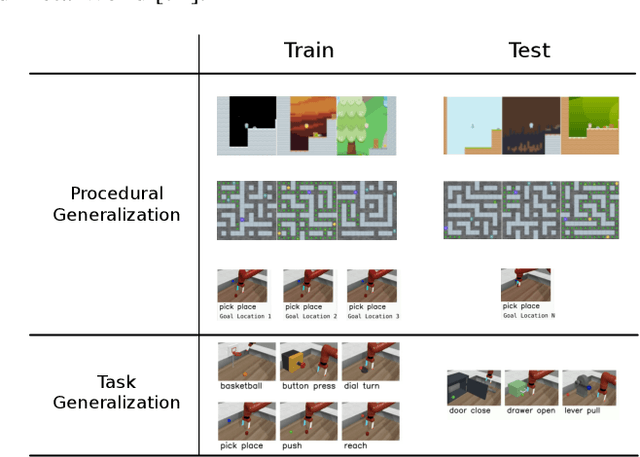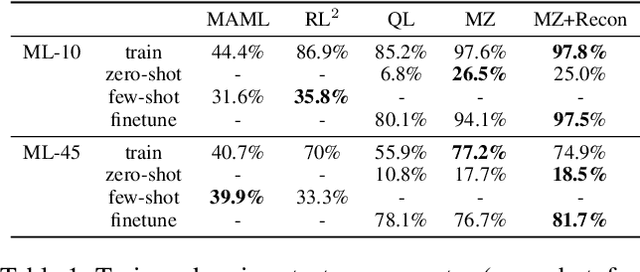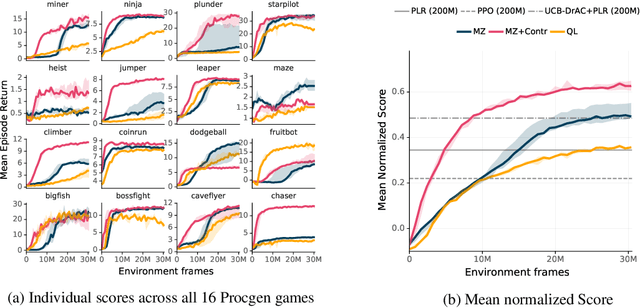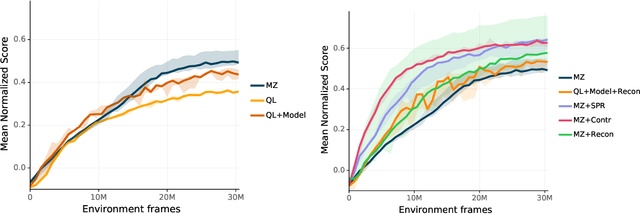Yazhe Li
Denoising Autoregressive Representation Learning
Mar 08, 2024Abstract:In this paper, we explore a new generative approach for learning visual representations. Our method, DARL, employs a decoder-only Transformer to predict image patches autoregressively. We find that training with Mean Squared Error (MSE) alone leads to strong representations. To enhance the image generation ability, we replace the MSE loss with the diffusion objective by using a denoising patch decoder. We show that the learned representation can be improved by using tailored noise schedules and longer training in larger models. Notably, the optimal schedule differs significantly from the typical ones used in standard image diffusion models. Overall, despite its simple architecture, DARL delivers performance remarkably close to state-of-the-art masked prediction models under the fine-tuning protocol. This marks an important step towards a unified model capable of both visual perception and generation, effectively combining the strengths of autoregressive and denoising diffusion models.
Transformers for Supervised Online Continual Learning
Mar 03, 2024



Abstract:Transformers have become the dominant architecture for sequence modeling tasks such as natural language processing or audio processing, and they are now even considered for tasks that are not naturally sequential such as image classification. Their ability to attend to and to process a set of tokens as context enables them to develop in-context few-shot learning abilities. However, their potential for online continual learning remains relatively unexplored. In online continual learning, a model must adapt to a non-stationary stream of data, minimizing the cumulative nextstep prediction loss. We focus on the supervised online continual learning setting, where we learn a predictor $x_t \rightarrow y_t$ for a sequence of examples $(x_t, y_t)$. Inspired by the in-context learning capabilities of transformers and their connection to meta-learning, we propose a method that leverages these strengths for online continual learning. Our approach explicitly conditions a transformer on recent observations, while at the same time online training it with stochastic gradient descent, following the procedure introduced with Transformer-XL. We incorporate replay to maintain the benefits of multi-epoch training while adhering to the sequential protocol. We hypothesize that this combination enables fast adaptation through in-context learning and sustained longterm improvement via parametric learning. Our method demonstrates significant improvements over previous state-of-the-art results on CLOC, a challenging large-scale real-world benchmark for image geo-localization.
Practical Kernel Tests of Conditional Independence
Feb 20, 2024



Abstract:We describe a data-efficient, kernel-based approach to statistical testing of conditional independence. A major challenge of conditional independence testing, absent in tests of unconditional independence, is to obtain the correct test level (the specified upper bound on the rate of false positives), while still attaining competitive test power. Excess false positives arise due to bias in the test statistic, which is obtained using nonparametric kernel ridge regression. We propose three methods for bias control to correct the test level, based on data splitting, auxiliary data, and (where possible) simpler function classes. We show these combined strategies are effective both for synthetic and real-world data.
Evaluating Representations with Readout Model Switching
Feb 19, 2023Abstract:Although much of the success of Deep Learning builds on learning good representations, a rigorous method to evaluate their quality is lacking. In this paper, we treat the evaluation of representations as a model selection problem and propose to use the Minimum Description Length (MDL) principle to devise an evaluation metric. Contrary to the established practice of limiting the capacity of the readout model, we design a hybrid discrete and continuous-valued model space for the readout models and employ a switching strategy to combine their predictions. The MDL score takes model complexity, as well as data efficiency into account. As a result, the most appropriate model for the specific task and representation will be chosen, making it a unified measure for comparison. The proposed metric can be efficiently computed with an online method and we present results for pre-trained vision encoders of various architectures (ResNet and ViT) and objective functions (supervised and self-supervised) on a range of downstream tasks. We compare our methods with accuracy-based approaches and show that the latter are inconsistent when multiple readout models are used. Finally, we discuss important properties revealed by our evaluations such as model scaling, preferred readout model, and data efficiency.
Investigating the role of model-based learning in exploration and transfer
Feb 08, 2023Abstract:State of the art reinforcement learning has enabled training agents on tasks of ever increasing complexity. However, the current paradigm tends to favor training agents from scratch on every new task or on collections of tasks with a view towards generalizing to novel task configurations. The former suffers from poor data efficiency while the latter is difficult when test tasks are out-of-distribution. Agents that can effectively transfer their knowledge about the world pose a potential solution to these issues. In this paper, we investigate transfer learning in the context of model-based agents. Specifically, we aim to understand when exactly environment models have an advantage and why. We find that a model-based approach outperforms controlled model-free baselines for transfer learning. Through ablations, we show that both the policy and dynamics model learnt through exploration matter for successful transfer. We demonstrate our results across three domains which vary in their requirements for transfer: in-distribution procedural (Crafter), in-distribution identical (RoboDesk), and out-of-distribution (Meta-World). Our results show that intrinsic exploration combined with environment models present a viable direction towards agents that are self-supervised and able to generalize to novel reward functions.
Efficient Conditionally Invariant Representation Learning
Dec 16, 2022



Abstract:We introduce the Conditional Independence Regression CovariancE (CIRCE), a measure of conditional independence for multivariate continuous-valued variables. CIRCE applies as a regularizer in settings where we wish to learn neural features $\varphi(X)$ of data $X$ to estimate a target $Y$, while being conditionally independent of a distractor $Z$ given $Y$. Both $Z$ and $Y$ are assumed to be continuous-valued but relatively low dimensional, whereas $X$ and its features may be complex and high dimensional. Relevant settings include domain-invariant learning, fairness, and causal learning. The procedure requires just a single ridge regression from $Y$ to kernelized features of $Z$, which can be done in advance. It is then only necessary to enforce independence of $\varphi(X)$ from residuals of this regression, which is possible with attractive estimation properties and consistency guarantees. By contrast, earlier measures of conditional feature dependence require multiple regressions for each step of feature learning, resulting in more severe bias and variance, and greater computational cost. When sufficiently rich features are used, we establish that CIRCE is zero if and only if $\varphi(X) \perp \!\!\! \perp Z \mid Y$. In experiments, we show superior performance to previous methods on challenging benchmarks, including learning conditionally invariant image features.
Sequential Learning Of Neural Networks for Prequential MDL
Oct 14, 2022



Abstract:Minimum Description Length (MDL) provides a framework and an objective for principled model evaluation. It formalizes Occam's Razor and can be applied to data from non-stationary sources. In the prequential formulation of MDL, the objective is to minimize the cumulative next-step log-loss when sequentially going through the data and using previous observations for parameter estimation. It thus closely resembles a continual- or online-learning problem. In this study, we evaluate approaches for computing prequential description lengths for image classification datasets with neural networks. Considering the computational cost, we find that online-learning with rehearsal has favorable performance compared to the previously widely used block-wise estimation. We propose forward-calibration to better align the models predictions with the empirical observations and introduce replay-streams, a minibatch incremental training technique to efficiently implement approximate random replay while avoiding large in-memory replay buffers. As a result, we present description lengths for a suite of image classification datasets that improve upon previously reported results by large margins.
Where Should I Spend My FLOPS? Efficiency Evaluations of Visual Pre-training Methods
Oct 06, 2022



Abstract:Self-supervised methods have achieved remarkable success in transfer learning, often achieving the same or better accuracy than supervised pre-training. Most prior work has done so by increasing pre-training computation by adding complex data augmentation, multiple views, or lengthy training schedules. In this work, we investigate a related, but orthogonal question: given a fixed FLOP budget, what are the best datasets, models, and (self-)supervised training methods for obtaining high accuracy on representative visual tasks? Given the availability of large datasets, this setting is often more relevant for both academic and industry labs alike. We examine five large-scale datasets (JFT-300M, ALIGN, ImageNet-1K, ImageNet-21K, and COCO) and six pre-training methods (CLIP, DINO, SimCLR, BYOL, Masked Autoencoding, and supervised). In a like-for-like fashion, we characterize their FLOP and CO$_2$ footprints, relative to their accuracy when transferred to a canonical image segmentation task. Our analysis reveals strong disparities in the computational efficiency of pre-training methods and their dependence on dataset quality. In particular, our results call into question the commonly-held assumption that self-supervised methods inherently scale to large, uncurated data. We therefore advocate for (1) paying closer attention to dataset curation and (2) reporting of accuracies in context of the total computational cost.
Procedural Generalization by Planning with Self-Supervised World Models
Nov 02, 2021



Abstract:One of the key promises of model-based reinforcement learning is the ability to generalize using an internal model of the world to make predictions in novel environments and tasks. However, the generalization ability of model-based agents is not well understood because existing work has focused on model-free agents when benchmarking generalization. Here, we explicitly measure the generalization ability of model-based agents in comparison to their model-free counterparts. We focus our analysis on MuZero (Schrittwieser et al., 2020), a powerful model-based agent, and evaluate its performance on both procedural and task generalization. We identify three factors of procedural generalization -- planning, self-supervised representation learning, and procedural data diversity -- and show that by combining these techniques, we achieve state-of-the art generalization performance and data efficiency on Procgen (Cobbe et al., 2019). However, we find that these factors do not always provide the same benefits for the task generalization benchmarks in Meta-World (Yu et al., 2019), indicating that transfer remains a challenge and may require different approaches than procedural generalization. Overall, we suggest that building generalizable agents requires moving beyond the single-task, model-free paradigm and towards self-supervised model-based agents that are trained in rich, procedural, multi-task environments.
Self-Supervised Learning with Kernel Dependence Maximization
Jun 15, 2021



Abstract:We approach self-supervised learning of image representations from a statistical dependence perspective, proposing Self-Supervised Learning with the Hilbert-Schmidt Independence Criterion (SSL-HSIC). SSL-HSIC maximizes dependence between representations of transformed versions of an image and the image identity, while minimizing the kernelized variance of those features. This self-supervised learning framework yields a new understanding of InfoNCE, a variational lower bound on the mutual information (MI) between different transformations. While the MI itself is known to have pathologies which can result in meaningless representations being learned, its bound is much better behaved: we show that it implicitly approximates SSL-HSIC (with a slightly different regularizer). Our approach also gives us insight into BYOL, since SSL-HSIC similarly learns local neighborhoods of samples. SSL-HSIC allows us to directly optimize statistical dependence in time linear in the batch size, without restrictive data assumptions or indirect mutual information estimators. Trained with or without a target network, SSL-HSIC matches the current state-of-the-art for standard linear evaluation on ImageNet, semi-supervised learning and transfer to other classification and vision tasks such as semantic segmentation, depth estimation and object recognition.
 Add to Chrome
Add to Chrome Add to Firefox
Add to Firefox Add to Edge
Add to Edge